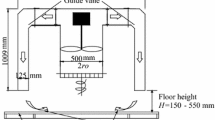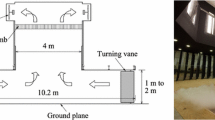Abstract
Roughness of a terrain is an important parameter that influences the near-ground flow field of tornadoes. In this study, both stationary and translating tornado-like vortices were simulated in a laboratory to investigate the influence of ground roughness on their flow fields. The near-ground flow fields, over the smooth and rough terrains, were studied using a mini version (1:3-scale) of the ISU tornado simulator and a 2D-PIV system for a stationary tornado and using the ISU tornado simulator and a pressure-based anemometer for a translating tornado. Main goal of this study is to examine the influence of ground roughness on tornado flow field. The results show that, for the stationary tornado, the flow regime transitioned from a multi-celled core structure over a smooth terrain at a higher swirl ratio to a single or dual-celled core structure over the rough terrain. A significant decrease in tangential velocity and core radius, and an increase in vertical and radial velocities and turbulent kinetic energy near the center of the tornado were also observed. For the translating tornado, ground roughness reduced the core radius, increased the radial velocity toward the center of rotation, and moved the location of the maximum horizontal velocity toward the front side of the tornado center close to the ground. There was a decrease in local or corner-flow swirl ratio in both stationary and translating tornadoes for the rough terrains compared with the smooth one.
Graphical abstract












Similar content being viewed by others
References
Bluestein BH, Pazmany LA (2000) Observation of tornadoes and other convective phenomena with a mobile 3-mm wavelength Doppler radar: the spring 1999 field experiment. Bull Am Meteorol Soc 81:2939–2951
Church CR, Snow JT (1993) Laboratory models of tornadoes. In: Church C, Burgess D, Doswell C, Davies-Jones R (eds) The tornado: its structure, dynamics, prediction, and hazards. American Geophysical Union, Washington, DC, pp 277–295
Church C, Snow JT, Baker GL, Agee EM (1979) Characteristics of tornado-like vortices as a function of swirl ratio: a laboratory investigation. J Atmos Sci 36(9):1755–1776
Dessens J Jr (1972) Influence of ground roughness on tornadoes. A laboratory simulation. J Appl Meteorol 11:72–75
Diamond CJ, Wilkins EM (1984) Translation effects on simulated tornadoes. J Atmos Sci 41(17):2574–2580
Fujita TT (1976) Graphic examples of tornadoes. Bull Am Meteorol Soc 57:401–412
Haan FL, Sarkar PP, Gallus WA (2007) Design, construction and performance of a large tornado simulator for wind engineering applications. Eng Struct. https://doi.org/10.1016/j.engstruct.2007.07.010
Karstens CD, Samaras TM, Lee BD, Finley CA (2010) Near-ground pressure and wind measurements in tornadoes. Mon Weather Rev 138:2570–2588
Lee W, Wurman J (2005) Diagnosed three-dimensional axisymmetric structure of the Mulhall tornado on 3 May 1999. J Atmos Sci 62:2373–2393
Leslie FW (1977) Surface roughness effects on suction vortex formation: a laboratory simulation. J Atmos Sci 34(7):1022–1027
Lettau H (1969) Note on aerodynamic roughness-parameter estimation on the basis of roughness-element description. J Appl Meteorol 8:828–832
Lewellen WS (1993) Tornado vortex theory. In: Church C, Burgess D, Doswell C, Davies-Jones R (eds) The tornado: its structure, dynamics, prediction, and hazards, Geophysical monograph series. American Geophysical Union, Washington, DC, pp 19–39. https://doi.org/10.1029/GM079p0019
Lewellen DC (2014) Local roughness effects on tornado dynamics. Local roughness effects on tornado dynamics. In: 27th Conference on severe local storms, paper 15A. American Meteor Society, Madison
Lewellen WS, Sheng YP (1979) Influence of surface conditions on tornado wind distributions. In: 11th Conference on severe local storms. American Meteorological Society, Boston, pp 375–381 (preprints)
Lewellen WS, Lewellen DC, Sykes RI (1997) Large-eddy simulation of a tornado’s interaction with the surface. J Atmos Sci 54(5):581–605
Lewellen DC, Lewellen WS, Xia J (2000) The influence of a local swirl ratio on tornado intensification near the surface. J Atmos Sci 57:527–544
Liu Z, Ishihara T (2016) Study of the effects of translation and roughness on tornado-like vortices by large-eddy simulations. J Wind Eng Ind Aerodyn 151:1–24
Lund DE, Snow JT (1993) Laser Doppler velocimetry measurements in tornado-like vortices. In: Church C, Burgess D, Doswell C, Davies-Jones R (eds) The tornado: its structure, dynamics, prediction, and hazards. American Geophysical Union, Washington, DC, pp 297–306
Matsui M, Tamura Y (2009) Influence of incident flow conditions on generation of tornado-like flow. In: Proceeding of the 11th American conference on wind engineering, Puerto Rico
Monji N, Wang Y (1989) A laboratory investigation of the characteristics of tornado-like vortices over various rough surfaces. Acta Meteorol Sin 3:506–515
Natarajan D, Hangan H (2012) Large eddy simulations of translation and surface roughness effects on tornado-like vortices. J Wind Eng Ind Aerodyn 104–106:577–584
Raupach MR, Antonia RA, Rajagopalan S (1991) Rough-wall turbulent boundary layers. Appl Mech Rev 44(1):1–25
Razavi A, Sarkar PP (2016) Laboratory investigation of the effect of tornado translation on its near-ground flow field. In: Proceeding of the 8th international colloquium on bluff body aerodynamics and applications, 7–11 June, 2016, Northeastern University, Boston, Massachusetts, USA
Razavi A, Sarkar PP (2018a) Laboratory investigation of the effects of translation on the near-ground tornado flow field. Wind Struct 26(3):179–190
Razavi A, Sarkar PP (2018b) Laboratory study of topography effects on the near-ground tornado flow field. J Bound Layer Meteorol. https://doi.org/10.1007/s10546-018-0347-5
Sarkar PP, Kardell R, Haan FL, Gallus WA (2003) Design of ISU tornado vortex simulator. In: Proceedings of the eleventh international conference on wind engineering, Lubbock, Texas, June 2–5
Sarkar PP, Haan FL, Gallus WA, Le K, Wurman J (2005) Velocity measurements in a laboratory tornado simulator and their comparison with numerical and full-scale data. In: Proceedings of the 37th US–Japan panel on wind and seismic effects joint meeting, Tsukuba, Japan, May 16–18
Wang J, Cao S, Pang W, Cao J (2017) Experimental study on effects of ground roughness on flow characteristics of tornado-like vortices. Bound Layer Meteorol 162(2):319–339
Zhang W, Sarkar PP (2008) Effects of ground roughness on tornado like vortex using PIV. In: Proceedings of the AAWE workshop, Vail, CO
Zhang W, Sarkar PP (2009) Influence of surrounding buildings on tornado-induced wind loads of a low-rise building. In: Proceedings of the 11th Americas conference on wind engineering, San Juan, Puerto Rico, June 22, 2009
Zhang W, Sarkar PP (2012) Near-ground tornado-like vortex structure resolved by particle image velocimetry (PIV). Exp Fluids 52:479–493
Acknowledgements
This research was supported by grants from NOAA (Award number NA06OAR4600230) and NSF (Award number CMMI-1400251).
Author information
Authors and Affiliations
Corresponding author
Additional information
Publisher’s Note
Springer Nature remains neutral with regard to jurisdictional claims in published maps and institutional affiliations.
Rights and permissions
About this article
Cite this article
Razavi, A., Zhang, W. & Sarkar, P.P. Effects of ground roughness on near-surface flow field of a tornado-like vortex. Exp Fluids 59, 170 (2018). https://doi.org/10.1007/s00348-018-2625-x
Received:
Revised:
Accepted:
Published:
DOI: https://doi.org/10.1007/s00348-018-2625-x




